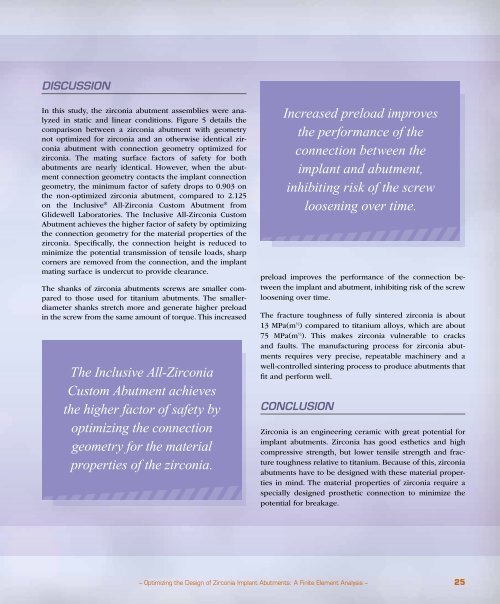PDF Download - Glidewell Dental Labs
PDF Download - Glidewell Dental Labs
PDF Download - Glidewell Dental Labs
Create successful ePaper yourself
Turn your PDF publications into a flip-book with our unique Google optimized e-Paper software.
DISCUSSION<br />
In this study, the zirconia abutment assemblies were analyzed<br />
in static and linear conditions. Figure 5 details the<br />
comparison between a zirconia abutment with geometry<br />
not optimized for zirconia and an otherwise identical zirconia<br />
abutment with connection geometry optimized for<br />
zirconia. The mating surface factors of safety for both<br />
abutments are nearly identical. However, when the abutment<br />
connection geometry contacts the implant connection<br />
geometry, the minimum factor of safety drops to 0.903 on<br />
the non-optimized zirconia abutment, compared to 2.125<br />
on the Inclusive ® All-Zirconia Custom Abutment from<br />
<strong>Glidewell</strong> Laboratories. The Inclusive All-Zirconia Custom<br />
Abutment achieves the higher factor of safety by optimizing<br />
the connection geometry for the material properties of the<br />
zirconia. Specifically, the connection height is reduced to<br />
minimize the potential transmission of tensile loads, sharp<br />
corners are removed from the connection, and the implant<br />
mating surface is undercut to provide clearance.<br />
The shanks of zirconia abutments screws are smaller compared<br />
to those used for titanium abutments. The smallerdiameter<br />
shanks stretch more and generate higher preload<br />
in the screw from the same amount of torque. This increased<br />
The Inclusive All-Zirconia<br />
Custom Abutment achieves<br />
the higher factor of safety by<br />
optimizing the connection<br />
geometry for the material<br />
properties of the zirconia.<br />
Increased preload improves<br />
the performance of the<br />
connection between the<br />
implant and abutment,<br />
inhibiting risk of the screw<br />
loosening over time.<br />
preload improves the performance of the connection between<br />
the implant and abutment, inhibiting risk of the screw<br />
loosening over time.<br />
The fracture toughness of fully sintered zirconia is about<br />
13 MPa(m ½ ) compared to titanium alloys, which are about<br />
75 MPa(m ½ ). This makes zirconia vulnerable to cracks<br />
and faults. The manufacturing process for zirconia abutments<br />
requires very precise, repeatable machinery and a<br />
well-controlled sintering process to produce abutments that<br />
fit and perform well.<br />
CONCLUSION<br />
Zirconia is an engineering ceramic with great potential for<br />
implant abutments. Zirconia has good esthetics and high<br />
compressive strength, but lower tensile strength and fracture<br />
toughness relative to titanium. Because of this, zirconia<br />
abutments have to be designed with these material properties<br />
in mind. The material properties of zirconia require a<br />
specially designed prosthetic connection to minimize the<br />
potential for breakage.<br />
– Optimizing the Design of Zirconia Implant Abutments: A Finite Element Analysis – 25

















